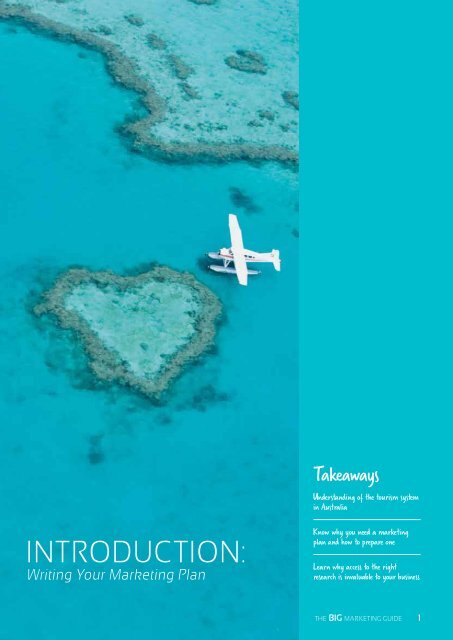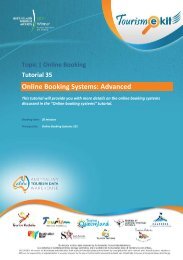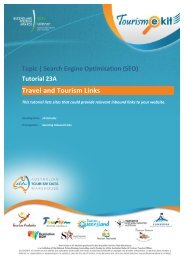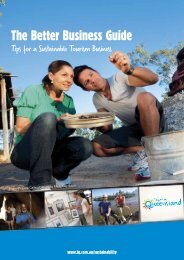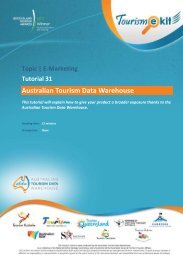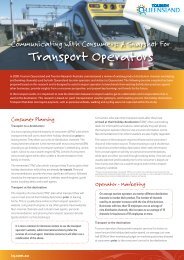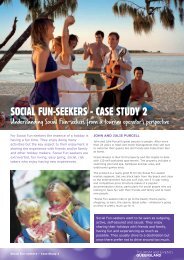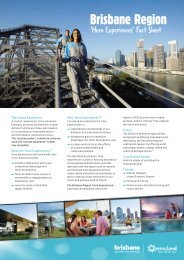Section 1: Introduction - Tourism Queensland
Section 1: Introduction - Tourism Queensland
Section 1: Introduction - Tourism Queensland
You also want an ePaper? Increase the reach of your titles
YUMPU automatically turns print PDFs into web optimized ePapers that Google loves.
Takeaways<br />
Understanding of the tourism system<br />
in Australia<br />
INTRODUCTION:<br />
Writing Your Marketing Plan<br />
Know why you need a marketing<br />
plan and how to prepare one<br />
Learn why access to the right<br />
research is invaluable to your business<br />
THE BIG MARKETING GUIDE<br />
1
INTRODUCTION | Writing your marketing plan<br />
WRITING<br />
YOUR<br />
MARKETING<br />
PLAN<br />
Cool Links<br />
Industry Assistance<br />
Industry Directory<br />
<strong>Introduction</strong><br />
As a <strong>Queensland</strong> tourism operator you’re part of one of the State’s largest and<br />
most diverse industries.<br />
Our industry is vibrant and dynamic and its strength lies in the success of operators<br />
like you.<br />
How you develop and market your business is important, not only to you personally,<br />
but to the government and industry bodies that represent your interests.<br />
As your State <strong>Tourism</strong> Office, <strong>Tourism</strong> <strong>Queensland</strong> (TQ) provides industry<br />
support, information and resources to help you make the most of your business<br />
opportunities and deliver solid returns on your investment.<br />
We do this in many ways. One example is the development of this marketing guide.<br />
The Big Marketing Guide was funded under the <strong>Queensland</strong> Government’s 10-year<br />
plan for tourism growth – the <strong>Queensland</strong> <strong>Tourism</strong> Strategy (QTS).<br />
It contains all the essential marketing information and resources you need to help<br />
get your business established and successfully competing in the marketplace.<br />
In addition to providing you with a marketing plan template and examples of how<br />
to develop your plan for day to day operational effectiveness, the guide also offers<br />
practical marketing advice, information, handy tips and web links to help you plan<br />
for a long and prosperous future in the tourism trade.<br />
THE BIG MARKETING GUIDE<br />
2
INTRODUCTION | Writing your marketing plan<br />
Why have a marketing plan?<br />
At this point you might be tempted to<br />
think you don’t need a marketing plan<br />
because you haven’t had one before<br />
and you’re doing OK. Or you don’t have<br />
the time to sit down and navel gaze –<br />
you have a business to run and you<br />
have a life.<br />
Well, let’s take a look at that. You make<br />
plans in order to get what you want.<br />
Planning is simply desiring something<br />
and putting into place the things that<br />
will help make it happen.<br />
It stands to reason if you plan to stay<br />
in business, you need to plan for<br />
business growth.<br />
And marketing is the primary<br />
method used to achieve that growth.<br />
Essentially, it directs the flow of<br />
goods and services from you to<br />
your consumers.<br />
You may have heard of the marketing<br />
term the ‘Four Ps’. It describes the<br />
marketing mix - a common set of<br />
business areas where marketing has<br />
a direct influence. For the purposes of<br />
this guide, we’re going to add a fifth P<br />
to cover Packaging.<br />
The five Ps are:<br />
• Product<br />
• Packaging<br />
• Price<br />
• Place<br />
• Promotion<br />
As we delve further into the planning<br />
process, you’ll see the Ps pick up on<br />
every aspect of the business and for<br />
this reason, the activities linked to<br />
Five P planning are both broad and<br />
interdependent.<br />
Along with sales, advertising and<br />
promotions, marketing plans also cover<br />
consumer/market research, product<br />
development, distribution, placement<br />
and positioning, customer service,<br />
public relations and corporate policies,<br />
systems and communication.<br />
As the business owner, you can also<br />
use the planning process to flip your<br />
view on the business and objectively<br />
assess your product, services and<br />
service delivery by looking at them<br />
from a consumer perspective.<br />
Thinking of marketing in these terms,<br />
it’s easy to see how critical it is to the<br />
everyday decision making you do for<br />
your business. In fact, the value and<br />
impact of marketing your product well<br />
cannot be underestimated.<br />
A marketing plan can help you:<br />
• identify your target markets<br />
• understand how to reach those<br />
target markets<br />
• present product to consistently<br />
meet consumer expectations<br />
• extend and /or develop<br />
new product<br />
• create and realise new<br />
opportunities<br />
• attract new and repeat<br />
customers<br />
• increase sales and<br />
• maximise the returns on<br />
your investment.<br />
The big picture<br />
Another important facet to<br />
your planning is having a good<br />
understanding of the external<br />
environment and how the tourism<br />
industry works. Not just understanding<br />
it, but becoming actively involved.<br />
As a tourism operator, you are an<br />
integral part of a tiered tourism<br />
industry system, which exists to<br />
develop tourism at national, state and<br />
local levels.<br />
Each level has its specific roles<br />
and responsibilities. However,<br />
collectively, they are a powerful<br />
force in driving consumer demand<br />
for our tourism product.<br />
Knowing how the system operates<br />
and tapping in to the various agencies<br />
and industry bodies as needs or<br />
opportunities arise can substantially<br />
enhance the effectiveness of your<br />
business marketing.<br />
The knowledge, networks and<br />
relationships gained through these<br />
and other professional affiliations can<br />
also lead to exciting and unexpected<br />
benefits as well as lifelong friendships.<br />
THE BIG MARKETING GUIDE<br />
3
INTRODUCTION | Writing your marketing plan<br />
Below is an overview of the tourism system, the key players and their various roles<br />
and responsibilities.<br />
The tourism system<br />
Sphere<br />
National<br />
State<br />
Regional<br />
Local<br />
Across national,<br />
state, regional<br />
and local<br />
Organisation<br />
Department of Resources, Energy and <strong>Tourism</strong> – the<br />
Department’s <strong>Tourism</strong> Division develops and implements<br />
federal government policy and programs. <strong>Tourism</strong> Research<br />
Australia sits with this federal department.<br />
<strong>Tourism</strong> Australia - the Australian Government agency<br />
responsible for the international and domestic marketing<br />
of Australia as a destination for leisure and business travel.<br />
<strong>Tourism</strong> Australia engages in international and domestic<br />
marketing, tourism events coordination, tourism research<br />
and tourism forecasting.<br />
Department of Employment, Economic Development and<br />
Innovation – the Department’s <strong>Tourism</strong> Division develops<br />
and implements State Government policy and programs.<br />
<strong>Tourism</strong> <strong>Queensland</strong> – the statutory authority responsible<br />
for marketing <strong>Queensland</strong> internationally and domestically,<br />
advising industry and government and destination<br />
development (including research and industry and market<br />
development).<br />
Regional <strong>Tourism</strong> Organisations – responsible for<br />
tourism marketing, leadership and development and the<br />
coordination of industry, local government and community<br />
destination marketing.<br />
Local governments – provide tourism infrastructure and<br />
facilities and facilitate and support tourism development<br />
and promotion.<br />
Local tourist organisations – enhance the visitor experience<br />
through the provision of information and advice, undertake<br />
marketing activity, and liaise with the community, local<br />
government and regional tourist organisations.<br />
National, state, regional, local and sector-specific<br />
associations – responsible for lobbying government,<br />
industry leadership, industry education and training,<br />
professional advice, raising industry standards, industry<br />
promotion and realising network opportunities.<br />
THE BIG MARKETING GUIDE<br />
4
INTRODUCTION | Writing your marketing plan<br />
THE<br />
MARKETING PLAN<br />
Getting started<br />
In the introduction we talked about the five Ps and<br />
described the marketing mix.<br />
We also talked about the value of having a marketing plan<br />
but here’s the catch…no plan is good unless it has true<br />
relevance to your business and you mean to follow and<br />
review it on a regular basis.<br />
In this section we outline the steps in developing a<br />
marketing plan.<br />
As you work through the process you’ll need to consider<br />
and include strategies that best fit your business and your<br />
budget now.<br />
Given the tourism industry is dynamic and susceptible to<br />
rapid change, it’s best to think of your plan as dynamic too<br />
and adjust your activities to suit market conditions as and<br />
when changes occur.<br />
Brainstorm ideas with people who work in your business,<br />
look at what other operators are doing and adopt or adapt<br />
their good ideas to suit your business and budget. Finally, call<br />
on the expertise of your Regional <strong>Tourism</strong> Organisation (RTO)<br />
contacts. They are there to back you up and advise you.<br />
All these things can help steer your planning in the<br />
right direction.<br />
The plan outline<br />
Planning is a creative process and when you’re passionate<br />
about your business it’s easy to throw all your energy<br />
behind the things that excite you most. However, a staged<br />
approached gives a logical flow and context to your ideas.<br />
It can stop you from running too far off track or getting<br />
caught up in a couple of ideas at the expense of others.<br />
You’ll find it easier to stay focused, and maintain a broad<br />
view and continuity in your thinking and planning by<br />
following a set format.<br />
THE BIG MARKETING GUIDE<br />
5
INTRODUCTION | Writing your marketing plan<br />
The marketing plan at a glance<br />
Stage<br />
Business<br />
Profile<br />
Description<br />
Describe the business<br />
What product/services it delivers<br />
Business Vision or Mission Statement<br />
Business Goals<br />
Competitive Advantages – what sets you apart from others<br />
Situation<br />
Analyses<br />
Describe key external environmental factors<br />
Describe key internal environmental conditions<br />
Develop a SWOT (Strengths, Weaknesses, Opportunities and<br />
Threats) matrix<br />
Research<br />
Identify your competitors and how they market their products<br />
Research the marketplace and identify consumer and travel trends<br />
Review your business and identify how your business meets<br />
consumers’ expectations through customer feedback<br />
Identify who your customers are and their preferences, motivations<br />
and media habits<br />
Market<br />
Identification<br />
Select your target market/s<br />
How your target markets behave and how to identify their needs<br />
Marketing<br />
Mix<br />
Product and Services<br />
How your product/services meet the needs and expectations of<br />
your target markets<br />
Packaging<br />
How you package your product to meet the expectations of your<br />
consumers<br />
Price<br />
How you price your product to be both competitive and profitable<br />
Place<br />
How you distribute your product and services<br />
Promotion<br />
How you convey your messages to your consumers<br />
Action Plan<br />
Describe your key strategies<br />
List the actions you need to undertake to fulfil the strategies<br />
Decide how and by how much you will measure your results and<br />
level of success<br />
Set realistic timeframes for achieving your actions<br />
Set a budget for each action so you can keep control of your<br />
expenditure<br />
Monitoring<br />
and Review<br />
Evaluate activities and measures<br />
Review and revise plan<br />
THE BIG MARKETING GUIDE<br />
6
INTRODUCTION | Writing your marketing plan<br />
Once you start writing the plan, it’s a good idea to avoid making it into some dreary<br />
document that sits on a shelf gathering dust. Below are some simple tips that will<br />
help you keep your plan real and relevant.<br />
Planning tips<br />
1. Be realistic Consider what you can achieve in a 12-month period and<br />
what resources you need and can commit to bring your<br />
plans to life. Resources include financial capacity, time and<br />
energy, and staff capability<br />
2. Keep it<br />
simple<br />
Be concise. Your plan should be short, easy to follow and to<br />
the point<br />
3. Prioritise Decide what you must do first and let the rest follow<br />
4. Cover your<br />
bases<br />
Set goals so you cover improvements to all key areas of<br />
the business. One goal for each part of the marketing mix<br />
might be a good way to start<br />
5. Include<br />
quick wins<br />
Set your goals so you achieve some quick wins as well as<br />
mid and longer term results<br />
The plan in detail<br />
So far, we’ve covered the concepts of a marketing plan from a high-level<br />
perspective. Now we’ll go through each stage and more fully explain the terms<br />
and their meanings, and how to apply your knowledge to create a plan that’s<br />
meaningful to your everyday operations.<br />
Business Profile<br />
This section is the preamble to your<br />
planning. It sets the parameters for<br />
your Action Plan.<br />
Describe your business and what<br />
services you deliver. Keep it brief and<br />
to the point – a few sentences should<br />
do it. This will be followed by your<br />
Mission or Vision Statement, Goals and<br />
Competitive Advantages.<br />
The Vision or Mission is a very short<br />
affirmation statement, not usually more<br />
than 10 words. An example might be:<br />
‘SceneXtreme is the Number One tour<br />
experience in <strong>Queensland</strong>’<br />
You can use the statement to guide<br />
what activities you take on by asking,<br />
‘Will this activity help SceneXtreme<br />
Tours to become the number one tour<br />
experience in <strong>Queensland</strong>?’ If the<br />
answer is no, you know not to do it<br />
and to spend your resources on other<br />
activities that will help you to achieve<br />
your Mission or Vision.<br />
Once you have a clear Vision of<br />
where you’re taking the business, you<br />
can develop some goals to help you<br />
get there.<br />
Your Goals should focus on improving<br />
your marketing advantage across all<br />
key aspects of the business. A helpful<br />
way to start might be to look at the five<br />
Ps and develop one goal for each P.<br />
The Goals underpin the Action Plan.<br />
Later in the plan you will develop<br />
strategies, activities, measures and<br />
allocate a budget to achieve each goal.<br />
THE BIG MARKETING GUIDE<br />
7
INTRODUCTION | Writing your marketing plan<br />
The following are example goals for<br />
SceneXtreme Tours:<br />
Product/Service Goal<br />
Enhanced product delivery and service<br />
quality through IT development and<br />
staff training<br />
Packaging Goal<br />
Expanded tour options on scenic<br />
routes based on a best fit product and<br />
marketing mix, to deliver profitability<br />
Price Goal<br />
Sales up by 20%, and profit margins up<br />
by 15% based on efficiency dividends<br />
Place Goal<br />
Improved and expanded sales<br />
opportunities through high internet<br />
exposure<br />
Promotion Goal<br />
Increased awareness and improved<br />
product profile through PR activity<br />
Competitive Advantage is another<br />
useful factor in defining your business.<br />
It describes your point of difference -<br />
what makes you unique or gives you<br />
the market edge over your competitors.<br />
In order to know your competitive<br />
advantage, you must first look at how<br />
your competitors operate and identify<br />
points of distinction. After all, that is<br />
what your potential customers do.<br />
Customers look at competitive<br />
advantage when they compare products<br />
to buy. Therefore, it’s vital to emphasise<br />
these qualities of difference in every<br />
aspect of your marketing strategy.<br />
Examples of competitive advantage<br />
include but are not limited to offering:<br />
• superior or unique product,<br />
facilities and/or services<br />
• price or package advantages<br />
• convenience or accessibility<br />
• superior safety or<br />
manufacturing standards.<br />
Your competitive advantage is usually<br />
listed under Strengths in your SWOT<br />
Analysis or alternatively, what you see<br />
as good ideas for development under<br />
Opportunities. We deal with the SWOT<br />
analysis next.<br />
Situation analysis<br />
This section provides the context for<br />
your marketing decision making and<br />
covers the benefits of Strengths,<br />
Weaknesses, Opportunities and<br />
Threats (SWOT) Analysis.<br />
As a business, you connect to the<br />
world in a number of ways. You are<br />
both a buyer and seller. You help to<br />
create the social and economic fabric<br />
within your community, and are often<br />
at the forefront of change.<br />
Understanding the internal and<br />
external environment and doing a<br />
SWOT Analysis of the business can<br />
strongly assist your marketing strategy.<br />
The most common way to undertake a<br />
situation analysis is to brainstorm ideas<br />
with a group of people directly involved<br />
with the business.<br />
External conditions are those factors<br />
you have no control over but they<br />
impact on your operations. The<br />
economy, pandemic outbreaks, legal<br />
and political issues, market trends and<br />
changes, competition, manufacturing<br />
or transport limitations, and so on.<br />
Internal conditions summarise your<br />
business environment and resources.<br />
They are factors that can be controlled<br />
through effective management.<br />
Depending on your business you<br />
may have specific areas to consider.<br />
However, in broad terms you might<br />
look at the financial status of the<br />
business and its resources, staff<br />
resources, training and development,<br />
premises, equipment, maintenance,<br />
suppliers and legal and other<br />
binding agreements.<br />
These quick and highline<br />
environmental scans can give you an<br />
idea of how well positioned you are to<br />
meet commercial and environmental<br />
challenges and take up new<br />
opportunities that offer growth.<br />
The SWOT gives you a snapshot of<br />
the business. It’s like a performance<br />
report card on what’s good, what<br />
needs improvement, how the business<br />
can expand and what issues it is likely<br />
to confront.<br />
Each factor is captured under at least<br />
one of the four categories. Sometimes<br />
a factor may be applicable to more than<br />
one category and that is fine, as long<br />
as you account for it in your planning.<br />
The trick is to focus on the major<br />
influences that have the most potential<br />
to affect the business, not to get<br />
caught up in the small stuff. Once<br />
again, jot down ideas as they come to<br />
you. The SWOT can easily be edited<br />
once you get in to the planning.<br />
The following example is indicative<br />
of how a business like SceneXtreme<br />
would develop its SWOT analysis and<br />
use the matrix for future development.<br />
THE BIG MARKETING GUIDE<br />
8
INTRODUCTION | Writing your marketing plan<br />
SWOT analysis<br />
Strengths Weaknesses Opportunities Threats<br />
Small tight-knit and hard<br />
Limited opportunity<br />
Internship and exchange<br />
Staff dissatisfaction<br />
working team of professional<br />
for staff training and<br />
program with local tertiary<br />
Staff turnover<br />
staff who treat the business<br />
development<br />
provider<br />
Knowledge gaps<br />
like it’s their own<br />
Only business of its type in<br />
Packages with new<br />
Possibility of Great Escape<br />
the region<br />
product on tour routes<br />
Tours establishing branch<br />
and increased brochure<br />
office in region<br />
exposure<br />
Price war<br />
Staff poaching<br />
Research<br />
Reliable research is an invaluable decision making tool. Used properly, market<br />
research can strongly guide you in making better choices for how to develop or<br />
refine your product, packaging, price, place and/or promotion. And your time,<br />
money and efforts are less likely to be wasted.<br />
Below are the key research areas you will need to cover-off in your marketing plan.<br />
By having this information you will be in a much stronger position to make sound<br />
decisions in how to effectively reach your target markets and gain the most from<br />
each marketing activity.<br />
1. Competitors 2. Market<br />
• products of a similar type to yours, both within and<br />
outside your region<br />
• other product and services that complement your<br />
business<br />
• gaps and niche market opportunities<br />
• consumer and travel trends<br />
• quarterly and annual results on visitors numbers,<br />
nights of stay and expenditure<br />
• market fluctuations and growth<br />
• emerging markets<br />
• technological developments<br />
3. Internal 4. Consumers<br />
• what benefits your business offers customers<br />
• what skills you need and what skills you look for<br />
in staff<br />
• whether you business is in the right location<br />
• if your business can be serviced locally<br />
• who the best suppliers are to offer value for money<br />
• who your customers are<br />
• why they visit your region<br />
• what experiences they look for<br />
• what expectations they have<br />
• how much they will pay for products and services<br />
THE BIG MARKETING GUIDE<br />
9
INTRODUCTION | Writing your marketing plan<br />
Because the market is a fluid<br />
environment, it’s important to regularly<br />
ask and seek the answers to these<br />
and other related questions. This way<br />
you can read the shifts and respond<br />
accordingly.<br />
A word of caution though - research<br />
is not a perfect science. There can be<br />
differences in findings, depending<br />
on the methods used to gather and<br />
interpret the data.<br />
<strong>Tourism</strong> research is undertaken by a<br />
number of bodies that offer excellent<br />
advice and resources. These are a good<br />
place to start.<br />
<strong>Tourism</strong> <strong>Queensland</strong> provides research<br />
on destination, state, national and<br />
international markets as well as general<br />
industry trends and domestic and<br />
international aviation updates. Always<br />
check the currency of the research you<br />
are using and subscribe to <strong>Tourism</strong><br />
<strong>Queensland</strong>’s releases and email<br />
updates for regular research news.<br />
Competitor research<br />
As a commercial enterprise your<br />
business will always have competitors.<br />
Knowing the competition and how they<br />
operate is just as important as knowing<br />
your customers.<br />
Research your competitors by:<br />
• studying where and how they<br />
advertise and promote their<br />
businesses<br />
• visiting their product and using<br />
their services<br />
• regularly checking their<br />
websites and subscribing to<br />
their mailing lists<br />
• monitoring their policies,<br />
practices and developments.<br />
This information can help you develop<br />
the competitive edge in your product<br />
quality and service delivery over other<br />
players in the marketplace.<br />
Market research<br />
Even though your business may be far<br />
from a capital city, the tourism industry<br />
operates in the global economy and is<br />
susceptible to rapid change.<br />
Consumers are more information savvy<br />
and more discerning in their choices<br />
than ever before. Market research<br />
enables you to follow and respond to<br />
fluctuations and changes in consumer<br />
trends and market conditions.<br />
A good way to keep in touch with<br />
consumer and market trends is<br />
through:<br />
• subscribing to trade journals<br />
and industry newsletters<br />
• membership to your RTO and<br />
industry bodies<br />
• attending industry seminars,<br />
conferences and market<br />
briefings<br />
• government agencies, e.g.<br />
<strong>Tourism</strong> <strong>Queensland</strong> and<br />
<strong>Tourism</strong> Australia<br />
• Australian Bureau of Statistics<br />
(ABS)<br />
• searching the internet and<br />
reading newspapers and<br />
magazines for relevant<br />
information.<br />
THE BIG MARKETING GUIDE<br />
10
INTRODUCTION | Writing your marketing plan<br />
Internal research<br />
It’s critical to remain objective about<br />
how your business stacks up against<br />
the competition, market conditions and<br />
consumer expectations. The fact is,<br />
no matter how good you are you can<br />
always be better.<br />
These days everyone talks about<br />
sustainability. A sustainable<br />
business does its planning based on<br />
economic, social and environmental<br />
accountabilities and outcomes. If that<br />
sounds complex, it is.<br />
A business demands close attention.<br />
Don’t be afraid to take a long hard<br />
look at how you are going, ask the<br />
tough questions and make the tough<br />
decisions. By constantly assessing your<br />
business positioning you can quickly<br />
introduce sustainable measures.<br />
Some ways to measure your business<br />
performance is through:<br />
• strong and ongoing planning,<br />
implementation and<br />
measurement<br />
• adoption of industry standards<br />
and high standards in your own<br />
policies and practices<br />
• membership to industry<br />
accreditation programs and<br />
benchmarking<br />
• training and development.<br />
Consumer research<br />
Most operators do customer research.<br />
Customer feedback is the most direct<br />
way to learn how your product and<br />
services are meeting the needs and<br />
expectations of your customers. It also<br />
helps you to better understand and<br />
define who your customers are, how<br />
you can best target them, and how you<br />
can improve your business and overall<br />
satisfaction rating.<br />
There are several ways to collect<br />
information about your consumers and<br />
gain insights into their preferences.<br />
However, quick response surveys such<br />
as room cards, guest books, courtesy<br />
calls, follow-up emails and online<br />
feedback forms are perhaps the most<br />
convenient.<br />
The important thing about collecting<br />
customer feedback is to correctly<br />
interpret the data and use it to its full<br />
advantage.<br />
Whatever research you do, see it as an<br />
opportunity to build the relationship<br />
between you and your customers. Your<br />
attitude towards customer feedback<br />
is a good test of how you value your<br />
customers, your business and your<br />
potential for growth.<br />
All feedback is positive because it<br />
creates an opportunity to learn and<br />
develop. No one will be more honest<br />
with you about your business than your<br />
customers.<br />
Respecting their advice and following<br />
up with action is the best way to<br />
enhance your operations on a daily<br />
basis and build strong connections<br />
with your consumer markets. When<br />
receiving feedback make sure you:<br />
• thank your customers for their<br />
feedback<br />
• respond professionally to all<br />
comments be they positive<br />
or negative<br />
• promote the positives that come<br />
out of the research<br />
• tackle negative feedback as<br />
it arises<br />
• include it as an item in your<br />
business plan if you can’t<br />
immediately deal with an issue,<br />
• ask your customers if they<br />
would like to join your<br />
mailing list<br />
• tell your customers about<br />
improvements through your<br />
newsletters, websites, and other<br />
promotional materials<br />
• attract their participation with<br />
promotional incentives that your<br />
customers will value.<br />
THE BIG MARKETING GUIDE<br />
11
INTRODUCTION | Writing your marketing plan<br />
Market Identification<br />
Once you have researched your<br />
markets, you can use the information<br />
to target markets that offer you the<br />
best opportunity for business.<br />
Generally, there are two types of<br />
research used to identify and define<br />
market segments. A segment is<br />
a group of customers with similar<br />
attitudes, behaviours and desires.<br />
The research types are Demographic<br />
research and Psychographic research.<br />
Demographics look at age, gender,<br />
occupation, income, family size<br />
and structure, education, place of<br />
residence, socio-economic groupings<br />
and lifestyles.<br />
Psychographics look at needs and<br />
wants, feelings and motivations - what<br />
consumers seek, what their holiday<br />
choices say about them, how they want<br />
to be seen, how they want to feel, what<br />
they can do, what is most important<br />
to them.<br />
Knowing how to directly engage with<br />
your consumers based on a clear<br />
understanding of their needs, wants<br />
and expectations will benefit every<br />
aspect of your business.<br />
There’s more information on identifying<br />
your target markets later in this guide.<br />
Marketing Mix<br />
We’ve talked briefly about the Ps, now it’s time to put some<br />
flesh on those bones.<br />
Product<br />
Product is the physical part of your business including your<br />
services. It is the experience you deliver. When looking at<br />
developing your product and product improvement you will<br />
need to consider:<br />
• Your product - always think about your consumers’<br />
points of view and what the benefits are from their<br />
perspective.<br />
• Your brand – what your product stands for and how<br />
you present your business to create an emotional<br />
connection with your consumers through words<br />
and images<br />
• Operational effectiveness – access, convenience, risk<br />
management, back-up suppliers and systems<br />
• Quality – value for money, meeting customer and<br />
industry standards, product distinctiveness<br />
• Safety – staff, consumer and environmental safety<br />
policies and procedures<br />
• Packaging – how you present your product, who you<br />
partner and market with as well as distribute through<br />
• Support – customer service<br />
• Warranty – living up to your promises<br />
• Accessories and services – value adding to your<br />
product and services with added extras.<br />
This list is indicative only and many of the topics related to<br />
Product are covered in greater detail in other sections of<br />
the guide.<br />
Product/Business life cycle<br />
You may need to use different marketing techniques<br />
depending on the stage your business has reached. The four<br />
stages referred to as the marketing bell curve include:<br />
Growth<br />
<strong>Introduction</strong><br />
Maturity<br />
1. <strong>Introduction</strong> – sales are slow and profits are absorbed into marketing and development<br />
2. Growth – the product gains marketplace acceptance, profitability increases<br />
3. Maturity – sales and profitability stabilise, marketing is required to attract new or<br />
repeat business<br />
4. Decline – sales decline and profits drop, marketing is needed to refresh the product.<br />
Decline<br />
THE BIG MARKETING GUIDE<br />
12
INTRODUCTION | Writing your marketing plan<br />
The good thing about the bell curve is that it reminds you<br />
not to get stuck doing the same old things year in and year<br />
out just because they worked at one stage. Mix things up,<br />
explore new ideas and methods of marketing.<br />
Markets and consumer trends are changing all the time and<br />
you need to be ahead of the game or at least in the game to<br />
maximise your business opportunities and profits.<br />
Packaging<br />
Packaging is a great way to extend your product and<br />
enhance the overall visitor experience. This can lead to a<br />
boost in sales, as you create more attractive packages that<br />
include special deals and offers.<br />
For example, an accommodation operator might include<br />
daily breakfast in a package deal. It’s about adding value<br />
to your product offering and in simple ways, creating value<br />
for consumers without becoming a major cost to your<br />
business. Packages are a useful marketing device to use<br />
during shoulder periods and for special occasions such as<br />
Valentines Day.<br />
Alternatively, you can work with other tourism and<br />
hospitality operators to bundle complimentary products and<br />
services into attractive<br />
packages that appeal<br />
to your mutual market<br />
interests. A business<br />
like SceneXtreme might<br />
package their breakfast<br />
hot air balloon tour with<br />
a lunch and afternoon<br />
winery tour offered at a<br />
local winery.<br />
Packaging is a simple<br />
way to add value to<br />
your product, tailor your<br />
marketing to meet the<br />
needs of your target<br />
markets, leverage off other businesses that carry strong<br />
market presence and create profit and marketability.<br />
The kinds of considerations you need to give to<br />
packaging are:<br />
• whether to package alone or team up with suitable<br />
packaging partners<br />
• what products and services would compliment<br />
• your business<br />
• what types of packages would appeal to your<br />
target markets, i.e. price discounts, extended stay,<br />
added extras.<br />
Packaging is covered in greater detail later in the guide.<br />
Price<br />
Pricing your product can be complex. No matter which<br />
markets you target, they all want value for money. In simple<br />
terms, pricing is all about putting a value on your product<br />
and packages while keeping them competitive with your<br />
opposition and correctly positioning you in your marketplace.<br />
Striking the balance between delivering good quality<br />
and value for money product and services and achieving<br />
profitability is a delicate balancing act.<br />
Your marketing plan needs to include a price strategy so you<br />
don’t inadvertently undermine your profit potential or create<br />
problems such as sparking a price war with your competitors.<br />
The strategy should be aimed towards building your<br />
profit through:<br />
• having the right product mix – some products and<br />
services offer better returns than others<br />
• meeting consumer/market expectations – customers<br />
are comfortable with the price and are happy to pay it<br />
• matching, in relative terms, competitor price<br />
structures – compete on a value for money basis<br />
• managing the pricing mix – accounting for volume<br />
discounts, wholesale pricing, commissions, cash and<br />
early payment deals, seasonal pricing, bundling or<br />
package pricing<br />
• identifying where your business can tolerate price<br />
flexibility.<br />
THE BIG MARKETING GUIDE<br />
13
INTRODUCTION | Writing your marketing plan<br />
In the case of an accommodation<br />
operator managing the pricing mix,<br />
one activity in their price strategy might<br />
be to offer discounts on three-nightminimum<br />
stays for group bookings.<br />
Place<br />
Distribution plays a huge part in the<br />
tourism industry. Getting your product<br />
and services to your customers is the<br />
primary goal of any business and there<br />
are critical decisions to be made about<br />
how you will take your product<br />
to market.<br />
You need to think about how your<br />
target customers will find and find<br />
out about your business whether it be<br />
through direct means such as walk-ins<br />
or phone sales, or via the internet, a<br />
tour desk, brochure or travel agent.<br />
Your target markets may have<br />
particular preferences for how they<br />
book and/or buy travel and tourism<br />
products and you need to know what<br />
these are as well.<br />
In almost all cases, your distribution<br />
partners and agents will take a<br />
commission of the sales. Pricing your<br />
product includes factoring in the cost<br />
of the distribution so everyone in the<br />
distribution chain makes a profit,<br />
including you.<br />
Because of its importance, we’ve<br />
covered distribution in a section of its<br />
own. But as a snapshot, here are some<br />
ideas to consider and questions to ask<br />
in relation to how you manage your<br />
distribution networks.<br />
• What distribution channels are<br />
available to you?<br />
• Who are the members for those<br />
distribution channels and do<br />
they reach your target markets?<br />
• How to achieve market<br />
coverage and include a mix of<br />
inclusive, selective, or exclusive<br />
distribution opportunities.<br />
• How best to manage your<br />
distribution inventory and<br />
variations in your product and<br />
service offerings.<br />
Promotion<br />
The big decisions about promoting<br />
your product are when, where, how and<br />
how much. There are many different<br />
ways to communicate with your target<br />
consumers.<br />
The challenge is to maximise your<br />
advertising and promotional spend<br />
by investing in the mediums your<br />
consumers are most likely to tap into.<br />
Your research should include questions<br />
about how your current consumers<br />
heard about you and also the media<br />
habits of your target markets. This<br />
information will be helpful when<br />
considering where to commit budget to<br />
gain consumer reach and attraction.<br />
Your marketing and communication<br />
campaign decisions can be broken<br />
down to include:<br />
• Advertising<br />
» brochures<br />
» television, radio, outdoor,<br />
magazine and transit<br />
internet<br />
• Digital Marketing<br />
» websites<br />
» blogs, travel/trip advisor sites<br />
and social networking sites<br />
such as You Tube, My Space,<br />
Facebook and Twitter,<br />
» internet marketing – search<br />
engines optimisation and<br />
advertising.<br />
• Public Relations and Publicity<br />
» familiarisations<br />
» media releases<br />
» PR kits<br />
• Personal Selling<br />
» trade Shows<br />
» consumer Shows<br />
» sales calls, missions and<br />
promotions<br />
» staff awareness training<br />
• Sales Promotions<br />
» sales incentives<br />
» competitions<br />
• Direct Marketing<br />
» telephone sales and<br />
marketing<br />
» mail outs<br />
» email<br />
Be aware that you will need to plan your<br />
promotional activity well in advance.<br />
When considering timing, you’ll need<br />
to think about when your consumers<br />
are likely to be most receptive to your<br />
advertising messages, and motivated<br />
to book. Marketing materials, print<br />
advertising and radio and television<br />
commercials can take quite a bit of<br />
time to develop and produce. You<br />
need to factor that time into your<br />
Action Plan to meet your desired<br />
production deadlines.<br />
For more information on promoting<br />
your product, take a look at the<br />
Domestic Marketing section of<br />
the guide.<br />
THE BIG MARKETING GUIDE<br />
14
INTRODUCTION | Writing your marketing plan<br />
Action Plan<br />
An Action Plan should state your strategy, activities, timeframes, measures and budget for each goal. The example below<br />
shows how you might go about developing your action plan.<br />
Product Goal: Enhanced product delivery and service quality through IT development and training<br />
Strategy Actions Timeframes Measures Budget<br />
Enhance web-based<br />
booking operations<br />
Identify and install<br />
suitable web-based<br />
booking and<br />
e-ticketing software<br />
01/09/XX<br />
Reduction in time spent taking<br />
phone bookings<br />
Increased efficiency and staff<br />
productivity<br />
24/7 booking capability<br />
Increased customer satisfaction<br />
Immediate online booking<br />
confirmation and e-ticketing<br />
$20,000<br />
Ongoing staff training<br />
in web-based business<br />
applications<br />
Roster staff for<br />
training purposes<br />
20/08/XX<br />
All staff trained in bookings and<br />
e-ticketing procedures<br />
Monitoring and Review<br />
It’s common sense to monitor how you are going in the rollout of your plan. You need to know if your strategies and actions<br />
are working, if you are gaining the expected results and if not, make the necessary changes.<br />
As mentioned earlier, customer feedback can tip you off to areas where you can improve or develop your product. Some of<br />
these things can be done quickly, others will take time.<br />
Nevertheless, the number one way to know if your plan is working for you is to have strong measures in place. Measuring<br />
your results will streamline your decision-making, and save you time and money.<br />
Some methods of measuring the performance of your marketing activities might include:<br />
• tracking enquiries and bookings received through advertising<br />
• asking your internet provider for tracking records of visitation to your website<br />
• increased exposure of your product through travel and tourism brochures<br />
• the number of travel agents that experience your product via familiarisations.<br />
It’s worthwhile knowing that access to and participation in some tourism, business and grant programs is reliant on having<br />
solid measuring practices in place.<br />
THE BIG MARKETING GUIDE<br />
15


